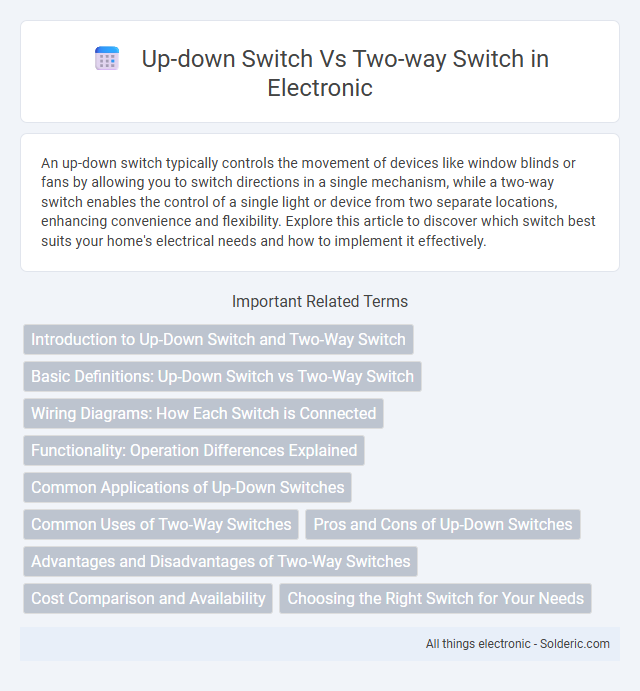An up-down switch typically controls the movement of devices like window blinds or fans by allowing you to switch directions in a single mechanism, while a two-way switch enables the control of a single light or device from two separate locations, enhancing convenience and flexibility. Explore this article to discover which switch best suits your home's electrical needs and how to implement it effectively.
Comparison Table
| Feature | Up-Down Switch | Two-Way Switch |
|---|---|---|
| Function | Controls devices by toggling up or down (e.g., fan speed, volume) | Controls a light or device from two different locations |
| Use Case | Adjust settings incrementally | Switch lights on/off from two spots (e.g., staircases, hallways) |
| Wiring | Simple, typically single-pole | Requires special two-way wiring (traveler wires) |
| Control Points | Single control point | Two control points |
| Common Applications | Fans, volume controls, blinds | Staircases, large rooms with multiple entrances |
Introduction to Up-Down Switch and Two-Way Switch
Up-down switches control devices by toggling between two distinct positions, making them ideal for applications requiring simple on/off or directional commands. Two-way switches are designed to control a single device from two different locations, commonly used in hallway or stairway lighting setups. Understanding the functional differences helps you select the right switch type for efficient lighting control and convenience.
Basic Definitions: Up-Down Switch vs Two-Way Switch
An up-down switch typically refers to a rocker or toggle switch that controls a device by moving the switch lever up or down to turn it on or off, commonly used for simple on/off operations. A two-way switch is part of a system allowing control of a single light or device from two different locations, featuring two switches interconnected to toggle the same fixture. While an up-down switch manages one control point, two-way switches enable more flexible and convenient lighting control in rooms with multiple entrances.
Wiring Diagrams: How Each Switch is Connected
An up-down switch wiring diagram typically involves a single pole double throw (SPDT) configuration, allowing for control of a device from one location by toggling between two terminals. Two-way switches require two separate SPDT switches wired in a three-way circuit, enabling control of a light or device from two different locations, with travelers connecting between the switches. Understanding your specific wiring setup ensures the correct switch type is installed for seamless functionality.
Functionality: Operation Differences Explained
An up-down switch operates by toggling a device between two states, such as raising or lowering window blinds, through distinct "up" and "down" positions. A two-way switch allows control of a single device, like a light, from two different locations, enabling you to turn it on or off from either switch point. Understanding these operational differences helps you choose the right switch for controlling devices based on location and function.
Common Applications of Up-Down Switches
Up-down switches are commonly used in applications requiring precise directional control, such as adjusting the position of window blinds, elevator controls, and volume settings on audio equipment. These switches enable users to easily toggle between upward and downward movements, offering intuitive and straightforward operation. Their design optimizes functionality in environments that demand reliable and quick adjustment of mechanical or electronic systems.
Common Uses of Two-Way Switches
Two-way switches are commonly used to control lighting fixtures from two different locations, such as at the top and bottom of staircases or in large rooms with multiple entrances. Your home may feature these switches in hallways or bedrooms, allowing convenient control without walking across the entire space. The up-down switch, by contrast, is typically found in devices requiring a simple on/off or directional control rather than multi-location switching.
Pros and Cons of Up-Down Switches
Up-down switches offer intuitive control for devices requiring simple directional operation, such as window blinds or volume adjustments, providing clear tactile feedback that reduces user errors. Their straightforward design ensures easy installation and durability, but they may lack the flexibility needed for complex circuits, unlike two-way switches that allow control from multiple locations. If your application demands basic directional input, up-down switches deliver reliability, but for multi-point control, two-way switches might better suit your needs.
Advantages and Disadvantages of Two-Way Switches
Two-way switches offer the advantage of controlling a lighting fixture from two different locations, enhancing convenience and functionality in spaces like hallways and staircases. However, their installation can be more complex and costly compared to single switches due to additional wiring requirements. A disadvantage includes potential confusion for users unfamiliar with the switching mechanism, possibly leading to improper use or troubleshooting difficulties.
Cost Comparison and Availability
Up-down switches generally cost less due to simpler mechanics and widespread manufacturing, making them readily available in most hardware stores. Two-way switches tend to be pricier because of their more complex wiring capabilities and limited supply in certain regions. Evaluating your project's needs against budget and access can help you decide the best switch type for your setup.
Choosing the Right Switch for Your Needs
Selecting the right switch requires understanding that an up-down switch typically controls a single device with two directional operations, such as window blinds or lifting mechanisms, offering precise control in vertical movements. In contrast, a two-way switch enables control of a single light or device from two different locations, ideal for staircases or large rooms where convenience and accessibility are key. Evaluate your specific application--motion direction control or multi-point switching--to determine which switch best meets your functional requirements.
up-down switch vs two-way switch Infographic

 solderic.com
solderic.com